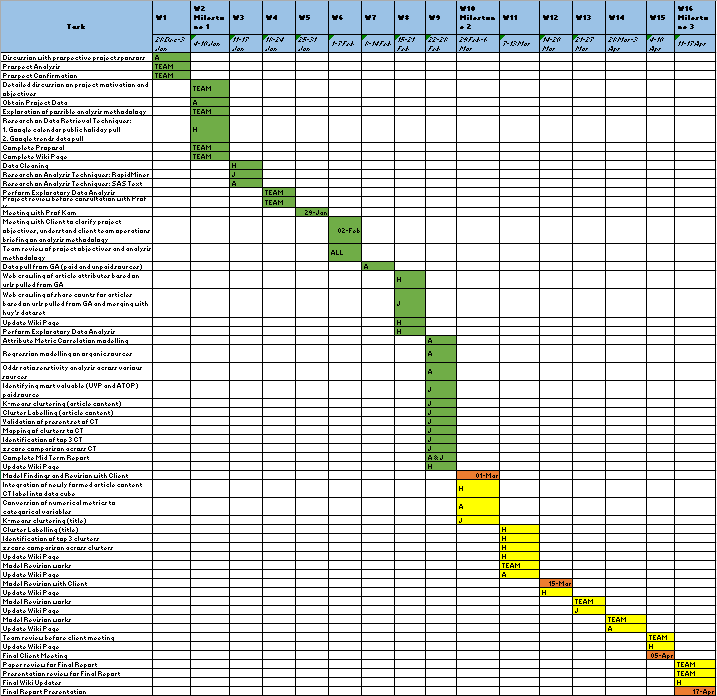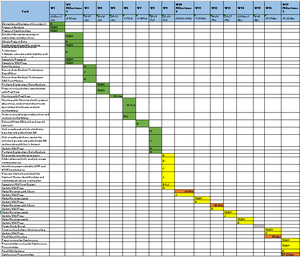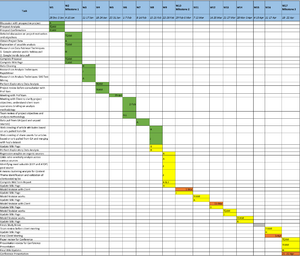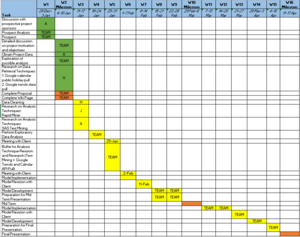Difference between revisions of "AY1516 T2 Team SkyTrek Project Management"
m (update project management page) |
(updated project management segment for mid term update) |
||
| Line 17: | Line 17: | ||
|} | |} | ||
<!--Header End--> | <!--Header End--> | ||
| + | ==<div style="background: #95A5A6; line-height: 0.3em; font-family:helvetica; border-left: #6C7A89 solid 15px;"><div style="border-left: #FFFFFF solid 5px; padding:15px;font-size:15px;"><font color= "#ffffff"><strong>Project Update</strong></font></div></div>== | ||
| + | <p> | ||
| + | Following the proposal review with the Professor Kam, the team shared their concerns in streamlining the project scope with the client. The following table demonstrates the final assessment of the project objectives. | ||
| + | </p> | ||
| + | |||
| + | {| class="wikitable" width="80%" | ||
| + | |- | ||
| + | !| Past Objective !! Mid Term Assessment | ||
| + | |- | ||
| + | | | ||
| + | *Identify the different web content factors that affect content performance in order to differentiate between high and low performing content | ||
| + | *What are the common attributes that lead to some content pieces drawing in most of the traffic? | ||
| + | *Is there an ideal standard format for news articles that best caters to the needs of the users? | ||
| + | || | ||
| + | Objectives could be streamlined to keep the focus on identifying high performing article attributes. | ||
| + | |- | ||
| + | |What are the most popular content themes that resonate with users in each of the given markets namely Singapore, Malaysia and Thailand? | ||
| + | ||Client’s primary objective is to explore insights pertaining to the Singapore news site | ||
| + | |- | ||
| + | |Should the strategic focus be on generating more articles to drive traffic or focus on fewer quality articles? | ||
| + | ||Client highlighted ongoing constraints in releasing more articles and preferred exploring the effectiveness of paid and unpaid articles. At | ||
| + | Client also expressed greater interest in increasing organic growth (unpaid searches) | ||
| + | |||
| + | |- | ||
| + | |Facilitate the content planning process by way of an interactive dashboard | ||
| + | ||[To be dropped] | ||
| + | Team presented advising professor’s concerns on project scope size and obtained client's approval to streamline project focus on the above mentioned objectives | ||
| + | |||
| + | |- | ||
| + | |What is the role of seasonality and annual trends in the online readership pattern of Skyscanner users? | ||
| + | ||[To be dropped] | ||
| + | Team presented advising professor’s concerns on project scope size and obtained client's approval to streamline project focus on the above mentioned objectives | ||
| + | |||
| + | |- | ||
| + | |How can the content planning process be streamlined in order to create maximum impact with minimal resources? | ||
| + | ||[To be dropped] | ||
| + | Objective involves a time consuming study of the team’s current content planning process which might not be feasible given the other high priority objective from the client | ||
| + | |||
| + | |} | ||
| + | |||
| + | <p> | ||
| + | The client further confirmed that this project’s primary objective is to identify how to increase returns of investments given her current efforts (limited resources). Further studying the information available and details of this project, the team finalized on the following project objectives: | ||
| + | </p> | ||
| + | <ol> | ||
| + | <li>To increase organic growth by identifying key article attributes that draw high levels of traffic and interest | ||
| + | <li>To identify cost-effective paid sources | ||
| + | <li>To identify and validate the most effective content themes for the Singapore market. Following which, the analysis process can be replicated for the Malaysia and Thailand market | ||
| + | </ol> | ||
| + | |||
| + | <p> | ||
| + | Over the course of our meetings with the client at Skyscanner, she pointed out that there are two main metrics in our data that are actionable- Unique Pageviews (UPVs) and Average Time on Page (ATOP). These two metrics are now the focus of our analysis in the sense that they would be used to define ‘performance’. Thus our analytical problem has shifted to understanding the factors that trend to drive these two main metrics. The implication of this is that UPVs and ATOP will now be the target or dependant variable and the goal of our further analysis would be to understand the relationship between these target variables and the other attributes in our dataset. To build on this change, we first need to define our data cube to better explain the relevance of each attribute. | ||
| + | </p> | ||
==<div style="background: #95A5A6; line-height: 0.3em; font-family:helvetica; border-left: #6C7A89 solid 15px;"><div style="border-left: #FFFFFF solid 5px; padding:15px;font-size:15px;"><font color= "#ffffff"><strong>Scope of Work</strong></font></div></div>== | ==<div style="background: #95A5A6; line-height: 0.3em; font-family:helvetica; border-left: #6C7A89 solid 15px;"><div style="border-left: #FFFFFF solid 5px; padding:15px;font-size:15px;"><font color= "#ffffff"><strong>Scope of Work</strong></font></div></div>== | ||
Revision as of 23:40, 28 February 2016
Project Update
Following the proposal review with the Professor Kam, the team shared their concerns in streamlining the project scope with the client. The following table demonstrates the final assessment of the project objectives.
| Past Objective | Mid Term Assessment |
|---|---|
|
Objectives could be streamlined to keep the focus on identifying high performing article attributes. |
| What are the most popular content themes that resonate with users in each of the given markets namely Singapore, Malaysia and Thailand? | Client’s primary objective is to explore insights pertaining to the Singapore news site |
| Should the strategic focus be on generating more articles to drive traffic or focus on fewer quality articles? | Client highlighted ongoing constraints in releasing more articles and preferred exploring the effectiveness of paid and unpaid articles. At
Client also expressed greater interest in increasing organic growth (unpaid searches) |
| Facilitate the content planning process by way of an interactive dashboard | [To be dropped]
Team presented advising professor’s concerns on project scope size and obtained client's approval to streamline project focus on the above mentioned objectives |
| What is the role of seasonality and annual trends in the online readership pattern of Skyscanner users? | [To be dropped]
Team presented advising professor’s concerns on project scope size and obtained client's approval to streamline project focus on the above mentioned objectives |
| How can the content planning process be streamlined in order to create maximum impact with minimal resources? | [To be dropped]
Objective involves a time consuming study of the team’s current content planning process which might not be feasible given the other high priority objective from the client |
The client further confirmed that this project’s primary objective is to identify how to increase returns of investments given her current efforts (limited resources). Further studying the information available and details of this project, the team finalized on the following project objectives:
- To increase organic growth by identifying key article attributes that draw high levels of traffic and interest
- To identify cost-effective paid sources
- To identify and validate the most effective content themes for the Singapore market. Following which, the analysis process can be replicated for the Malaysia and Thailand market
Over the course of our meetings with the client at Skyscanner, she pointed out that there are two main metrics in our data that are actionable- Unique Pageviews (UPVs) and Average Time on Page (ATOP). These two metrics are now the focus of our analysis in the sense that they would be used to define ‘performance’. Thus our analytical problem has shifted to understanding the factors that trend to drive these two main metrics. The implication of this is that UPVs and ATOP will now be the target or dependant variable and the goal of our further analysis would be to understand the relationship between these target variables and the other attributes in our dataset. To build on this change, we first need to define our data cube to better explain the relevance of each attribute.
Scope of Work
As part of the Travel-News Traffic Optimization Project the team will be responsible for performing tasks throughout various stages of this project. The following is a list of these tasks which will result in the successful completion of this project:
Project Sourcing
- Meeting with prospective clients to understand project requirements
- Team assessment of project feasibility
- Project confirmation with client
- Obtain dataset from client
Problem Definition
- Understanding business problem
- Understanding analytical problems
- Understanding analytical methodologies
- Document all meeting minutes
Data Preparation
- Data cleaning
- External data source crawling
- Data merging
- Data loading
- Research on data analysis tools
- Research data analysis methodologies
Data Exploration
- EDA analysis
Design phase
- Finalize business problem
- Finalize analytical problems
- Finalize analytical tools
- Finalize analytical methodology
Implementation Phase
- Analysis
- Complete news article set analysis
- K means clustering
- Cluster labelling
- Cluster label – Client content theme (CT) analysis
- Validation of present set of CT
- Mapping of clusters to CT
- CT metric analysis
- Identification of top 3 CT
- Z score comparison across CT
- Organic growth analysis
- Attribute Metric Correlation modelling
- Regression modelling
- Paid source analysis
- Data visualization and exploration
- Identifying most valuable (UVP and ATOP) paid source
- Odds ratio source switching sensitivity analysis
- Data visualization and exploration
- Titles Text Analysis
- K means clustering
- Cluster labelling
- Cluster metric analysis
- Identification of top 3 clusters
- Z score comparison across clusters
- Complete news article set analysis
- Proposal report
- Mid-term report
- Final report
Control & Monitoring
- Fortnight basis
- Review with client
- Review with Prof Kam
- Weekly basis
- Team meeting update
- Wiki update



